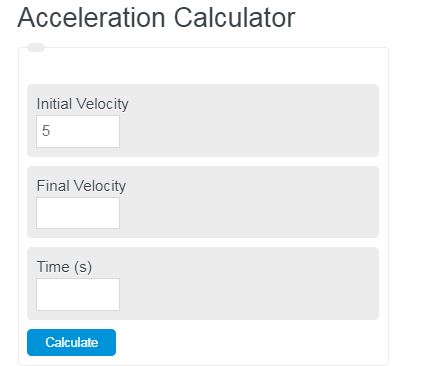Jump to Calculator Links
- Acceleration From Velocity & Time
- Acceleration From Force and Mass
- Acceleration From Distance, Initial Velocity & Time
- Angular Acceleration
Calculate the acceleration of an object, also known as the rate of change of velocity. Enter the initial velocity, final velocity, and time to calculate acceleration.
Related Calculators
- Force Calculator
- Velocity Calculator
- Angular Velocity Calculator
- Angular Acceleration Calculator
- Momentum Calculator
- Work Calculator
- Average Acceleration Calculator
- Magnitude of Acceleration Calculator
- Constant Acceleration Calculator
Acceleration Formula
The following three formulas are used to calculate acceleration:
a = F / m
a = (Vf-Vi) / ΔT
a = 2*(ΔD – Vi * ΔT) / ΔT^2
- Where a is the acceleration
- Vf is the final velocity
- Vi is the initial velocity
- ΔD is the change in distance
- ΔT is the change in time
- F is force
- m is mass
What is Acceleration?
Acceleration is a measure of the change in velocity with respect to a change in time. In other words, it’s a measure of how quickly the velocity is changing.
Acceleration occurs when a force acts upon an object of a given mass. The force is measured as a net force, meaning the sum of all forces acting on the object.
Force is typically displayed as a vector quantity, meaning it has direction, and therefore acceleration is also a vector quantity.
What are the units of Acceleration?
In Si units, acceleration is displayed as meters per second squared (m/s^2), velocity is measured in meters per second (m/s), and time is measured in seconds (s).
To explore other units of acceleration, you can use our unit converter that is stickied to the side of the page on the desktop and below the acceleration calculators on mobile.
How to Calculate Acceleration
We will now look at how to calculate the acceleration of an object. Let’s assume we are given an initial velocity, initial position, final position, and time.
First, we need to lay out our plan of attack for solving this problem. To calculate acceleration, we need both the initial velocity and the final velocity.
To do this, we will calculate the average velocity through the change in position. Then, once we have the average velocity, we will use that and the initial velocity to calculate the final velocity.
Afterward, we have all the information we need, and we can calculate the acceleration from the velocities and changes in time.
Example Problem #1:
For this example, the values for the initial and final velocity, as well as the time, must be known.
First, the initial velocity is measured as 11 m/s.
Next, a stopwatch is started and stopped over the period of time the object is accelerated. It reads 10 seconds.
Next, the final velocity is measured to be 31 m/s.
Finally, the acceleration is calculated using the formula above:
Acceleration = (Final Velocity – Initial Velocity) / Time
Acceleration = 31-11 / 10
Acceleration = 2 m/s^2

